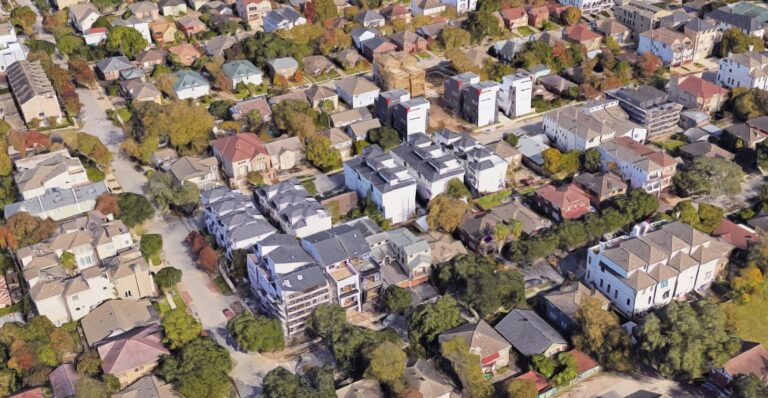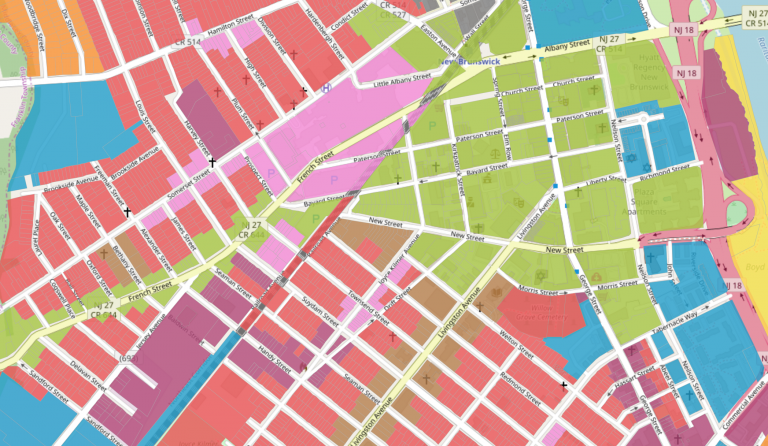Physical Address
304 North Cardinal St.
Dorchester Center, MA 02124
Physical Address
304 North Cardinal St.
Dorchester Center, MA 02124
I recently discovered a new logical fallacy: the “Morton’s Fork” fallacy. This argument is one in which contradictory observations lead to the same conclusion. For example, if I argue that new housing near public transit is bad because it (1) spurs gentrification by bringing rich people into the neighborhood and (2) increases crime by bringing poor people into the neighborhood, I am engaging in this fallacy. Similarly, I have heard arguments that new housing is bad because it (1) brings down property values and (2) increases property values. In such situations, it is sometimes possible that one of the two claims could be true, but it is unlikely that both claims could be true.

In most of my discussions of Houston here on the blog, I have always been quick to hedge that the city still subsidizes a system of quasi-private deed restrictions that control land use and that this is a bad thing. After reading Bernard Siegan’s sleeper market urbanist classic, “Land Use Without Zoning,” I am less sure of this position. Toward this end, I’d like to argue a somewhat contrarian case: subsidizing private deed restrictions, as is the case in Houston, is a good idea insomuch as it defrays resident demand for more restrictive citywide land-use controls. For those of you who haven’t read my last four or five wonky blog posts on land-use regulations in Houston (what else could you possibly be doing?), here is a quick refresher. Houston doesn’t have conventional Euclidean zoning. Residents voted it down three times. However, Houston does have standard subdivision and setback controls, which serve to reduce densities. The city also enforces high minimum parking requirements outside of downtown. On top of these standard land-use regulations, the city heavily relies on private deed restrictions. Also known as restrictive covenants, these are essentially legal agreements among neighbors about how they can and cannot use their property, often set up by a developer and signed onto as a condition for buying a home in a particular neighborhood. In most cities, deed restrictions cover superfluous lifestyle preferences not already covered by zoning, including lawn maintenance and permitted architectural styles. In Houston, however, these perform most of the functions normally covered by zoning, regulating issues such as permissible land uses, minimum lot sizes, and densities. Houston’s deed restrictions are also different in that they are heavily subsidized by the city. In most cities, deed restrictions are overseen and enforced by parties to a deed, typically organized as a […]

Houston doesn’t have zoning. As I have written about previously here on the blog, this doesn’t mean nearly as much as you would think. Sure, Houston’s municipal government doesn’t segregate uses or expressly regulate densities. But as my Market Urbanism colleague Michael Lewyn has documented, city officials do regulate lot sizes, setbacks, and parking requirements. They also enforce private deed restrictions, which blanket many of the city’s residential neighborhoods. A deed restriction is a legal agreement among neighbors about how they can and cannot use their property. In most cities, deed restrictions are purely private and often fairly marginal, adding rules on top of zoning that property owners must follow. But in Houston, deed restrictions do most of the heavy lifting typically covered by zoning, including delineating permissible uses and design standards. Whenever I point out that Houston has relatively light land-use regulations (and is enjoying the benefits), folks often respond that the city’s deed restrictions are basically zoning. This couldn’t be further from the truth. Before I turn to the essential differences, it’s worth first observing how Houston’s deed restrictions are like any other city’s zoning. First, like zoning, Houston’s deed restrictions are almost universally designed to prop up the values of single-family houses. Despite the weak evidence for a use segregation-property values connection, this justification for zoning goes back to the program’s roots in the 1920s. Many of Houston’s nicest residential neighborhoods, like River Oaks and Tanglewood, follow this line of thinking, enforcing tight deed restrictions on residents that come out looking a lot like zoned neighborhoods in nearby municipalities like Bellaire and Jersey Village. Second, both zoning and Houston’s deed restrictions are enforced by government officials at taxpayer expense. In most other cities, deed restrictions are overseen and enforced by a private group like a homeowners association, […]

The great failing of modern land-use regulation is the failure to allow densities to naturally change over time. Let me explain. Imagine you are trying to sell a property you own in a desirable inner suburban neighborhood in your town. The lot is 4,000 square feet and hosts an old 4,000 square-foot home. There is incredible demand for housing in this area; perhaps the schools are good, or the amenities are nice, or the neighborhood sits adjacent to a major jobs center, meaning that residents can walk to work. I’ll leave the reasons to you. Who do you sell it to? You have at least two options: First, you could sell it to a wealthy individual, who would use the entire property as his home. He is willing to pay the market rate for single-family homes like this, which in this case is $300,000. Under current financing, he would likely have a monthly mortgage payment in the ballpark of $1,300. Second, you could sell it to a developer who intends to subdivide the house into four 1,000 square foot one-bedroom apartments, renting each of them at a market rate of $500 to service workers who commute to downtown. After factoring in expenses, her annual net operating income would be around $20,160. Assuming a multifamily cap rate of 6.0.%, this means that she could pay up to $336,000 for your property. Based on this analysis, who do you sell it to? The answer is obvious: you will sell it to the multifamily developer who will subdivide and rent out the house, not necessarily because you’re a bleeding heart urbanist, but in order to maximize your earnings. As rents in the area rise, the pressure to sell to a buyer who would densify the property will only grow. The prospective mansion buyer […]

In my regular discussions of U.S. zoning, I often hear a defense that goes something like this: “You may have concerns about zoning, but it sure is popular with the American people. After all, every state has approved of zoning and virtually every city in the country has implemented zoning.” One of two implications might be drawn from this defense of Euclidean zoning: First, perhaps conventional zoning critics are missing some redeeming benefit that obviates its many costs. Second, like it or not, we live in a democratic country and zoning as it exists today is evidently the will of the people and thus deserves your respect. The first possible interpretation is vague and unsatisfying. The second possible interpretation, however, is what I take to really be at the heart of this defense. After all, Americans love to make “love it or leave it” arguments when they’re in the temporary majority on a policy. But is Euclidean zoning actually popular? The evidence for any kind of mass support for zoning in the early days is surprisingly weak. Despite the revolutionary impact that zoning would have on how cities operate, many cities quietly adopted zoning through administrative means. Occasionally city councils would design and adopt zoning regimes on their own, but often they would simply authorize the local executive to establish and staff a zoning commission. Houston was among the only major U.S. city to put zoning to a public vote—a surefire way to gauge popularity, if it were there—and it was rejected in all five referendums. In the most recent referendum in 1995, low-income and minority residents voted overwhelmingly against zoning. Houston lacks zoning to this day. Meanwhile, the major proponents of early zoning programs in cities like New York and Chicago were business groups and elite philanthropists. Where votes were […]
Suburb: Planning Politics and the Public Interest is a scholarly book about planning politics in Montgomery County, a (mostly) affluent suburb of Washington, D.C. The book contains chapters on redevelopment of inner ring, transit-friendly areas such as Friendship Heights and Silver Spring, but also discusses outer suburbs and the county’s agricultural areas. From my perspective, the most interesting section of the book was the chapter on Friendship Heights and Bethesda, two inner-ring areas near subway stops. When landowners proposed to redevelop these areas, the planning staff actually downzoned them (p. 56)- and NIMBYs fought the planning board, arguing that even more downzoning was necessary to prevent unwelcome development. These downzoning decisions were based on the staff’s “transportation capacity analysis”- the idea that an area’s roads can only support X feet of additional development. For example, Hanson writes that Friendship Heights “could support only 1.6 million square feet of additional development.” (p. 62). Similarly, he writes that Bethesda’s “roads and transit could handle only 12 million square feet of new development at an acceptable level of service.” (p. 75) Thus, planning staff artificially limited development based on “level of service “(LOS) . “Level of service” is a concept used to grade automobile traffic; where traffic is free-flowing the LOS is A. But the idea that development is inappropriate in low-LOS places seems a bit inconsistent with my experience. Bethesda and Friendship Heights zip codes have about 5000-10,000 people per square mile; many places with far more density seem to function adequately. For example, Kew Gardens Hills in central Queens has 27,000 people per square mile, relies on bus service, and yet seems to be a moderately popular area. Moreover, the use of LOS to cap density has a variety of other negative effects. First, places with free-flowing traffic tend to be dangerous for […]

The adoption of zoning as a means of preventing external costs led to inefficient use of land and caused many individuals to suffer great unfairness.
by Samuel R Staley Before the twentieth century land-use and housing disputes were largely dealt with through courts using the common-law principle of nuisance. In essence if your neighbor put a building, factory, or house on his property in a way that created a measurable and tangible harm, courts could intervene on behalf of a complainant to force compensation or stop the action. This pro-property rights approach maximized liberty and minimized the ability of citizens and elected officials to politicize the development process. This changed with the Progressive movement. Beginning in the late nineteenth century, Progressives argued that government should become more professional. Rather than being limited, government should use its resources to pursue the “public interest,” loosely defined as whatever the general public decided through democratic processes was the proper scope of government. Legislatures and, by extension, city commissions made up of elected citizens would set policy and goals while a cadre of trained professionals would use the techniques of scientific management to implement policies. One of the leading Progressives of the day, Woodrow Wilson, was skeptical of the value of elected bodies such as Congress because they interfered with scientific management of government. While many in the twenty-first century might be tempted to dismiss this public-interest view of government—indeed an entire academic subdiscipline, Public Choice, has emerged to demonstrate the foibles of governments and explore “government failure”—Progressive ideas held a lot of appeal at the turn of the twentieth century. In addition to national concerns over industries such as oil, steel, and railroads, local governments were rife with corruption, waste, and inefficiency. Reforms, such as the city-manager form of government, civil-service exams, and in some cases even municipal ownership of utilities, were thought to provide more transparency and accountability than the patronage-laden times of political bosses. (Today municipal […]

This is the first article of a five-part series on suburbia in the United States. In primary school, one of my friends lived in a duplex. This fact blew my mind. To my inexperienced 7-year-old mind, a duplex barely registered as a house. Her family shared a driveway with their neighbors, and their yard was tiny. It was the first house I’d ever seen that shared a wall with its neighbors. I’d seen apartments of course, but in my mind those were temporary, for people who who were saving up to buy a “real” home. I couldn’t understand that some people might actually prefer to live in something besides a private home, because I’d never come across it before. Median income in American cities tends to rise at about 8 percent per mile as one moves away from the business district. My mental model of the world was pretty typical for an American child brought up in a single-family home. It’s easy to see why—US residential development is dominated by suburbs, and home ownership is touted as the ultimate symbol of prosperity. Other types of dwellings tend to be for young people starting out in life or low income households unable to afford a place of their own. The popular image of the American Dream includes a white picket fence and a car, not an apartment and a subway pass. This is in stark contrast with most other countries. The French word for suburb is banlieue, and it has come to connote poverty and social isolation, because that is where immigrants and the poor tend to live. They’ve been known as “red suburbs” because of their tendency to vote Communist. Meanwhile, the wealthy live in the city center. In South Africa, the inner city is reserved for the privileged white […]

During his last days in office, former Representative Jason Chaffetz must have forgotten he is supposed to be a fiscal conservative. His recent comments that members of Congress need $2,500 stipends to afford housing in DC reflect a complete ignorance of both the reasons for high housing prices and the best ways to lower those prices. Instead of treating the symptoms of skyrocketing housing prices, policymakers should be striking at the root: rent control, height limits, and burdensome zoning restrictions that discourage development. All of this turns on basic economics. Markets drive prices of goods and services down, but only if they are competitive. In many cases, existing interests try to prevent others from entering markets in order to protect their own bottom lines. Zoning regulations are often manipulated by interest groups, who hope to limit the allowed uses of land within a city and prevent future developments. Zoning essentially fixes the amount of available housing by discouraging developers from building more housing, ultimately driving housing prices up. Academic research places much of the blame for high housing costs on zoning––and this isn’t just limited to a single city or state. Edward Glaeser and Raven Saks of Harvard and Joseph Gyourko of the University of Pennsylvania examined Manhattan’s housing market estimate that new construction costs for housing are only about $300 per square foot, but that square foot tends to be rented out for $600, twice the cost at construction. Glaeser, Gyourko, and Saks write, quite intuitively, that “this would seem to offer an irresistible opportunity for developers.” But it’s zoning regulations that prevent developers from coming in to build more homes (which ultimately lowers housing prices), despite market incentives. Even though there is a deafening clamor for more housing, as evidenced by rising prices, building takes so long in […]